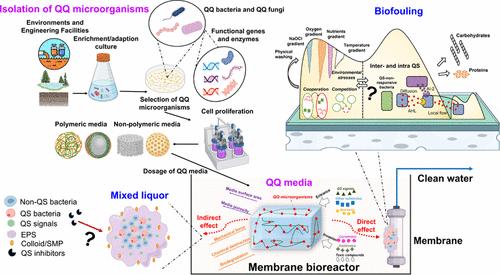当前位置:
X-MOL 学术
›
Environ. Sci. Technol.
›
论文详情
Our official English website, www.x-mol.net, welcomes your
feedback! (Note: you will need to create a separate account there.)
Quorum Quenching in Membrane Bioreactors for Fouling Retardation: Complexity Provides Opportunities
Environmental Science & Technology ( IF 10.8 ) Pub Date : 2024-07-16 , DOI: 10.1021/acs.est.4c04535 Boyan Xu 1, 2 , Qingxian Su 1, 2, 3 , Yuxin Yang 1 , Shujuan Huang 4 , Yue Yang 5 , Xueqing Shi 4 , Kwang-Ho Choo 6 , How Yong Ng 1, 2 , Chung-Hak Lee 7
Environmental Science & Technology ( IF 10.8 ) Pub Date : 2024-07-16 , DOI: 10.1021/acs.est.4c04535 Boyan Xu 1, 2 , Qingxian Su 1, 2, 3 , Yuxin Yang 1 , Shujuan Huang 4 , Yue Yang 5 , Xueqing Shi 4 , Kwang-Ho Choo 6 , How Yong Ng 1, 2 , Chung-Hak Lee 7
Affiliation

|
The occurrence of biofouling restricts the widespread application of membrane bioreactors (MBRs) in wastewater treatment. Regulation of quorum sensing (QS) is a promising approach to control biofouling in MBRs, yet the underlying mechanisms are complex and remain to be illustrated. A fundamental understanding of the relationship between QS and membrane biofouling in MBRs is lacking, which hampers the development and application of quorum quenching (QQ) techniques in MBRs (QQMBRs). While many QQ microorganisms have been isolated thus far, critical criteria for selecting desirable QQ microorganisms are still missing. Furthermore, there are inconsistent results regarding the QQ lifecycle and the effects of QQ on the physicochemical characteristics and microbial communities of the mixed liquor and biofouling assemblages in QQMBRs, which might result in unreliable and inefficient QQ applications. This review aims to comprehensively summarize timely QQ research and highlight the important yet often ignored perspectives of QQ for biofouling control in MBRs. We consider what this “information” can and cannot tell us and explore its values in addressing specific and important questions in QQMBRs. Herein, we first examine current analytical methods of QS signals and discuss the critical roles of QS in fouling-forming microorganisms in MBRs, which are the cornerstones for the development of QQ technologies. To achieve targeting QQ strategies in MBRs, we propose the substrate specificity and degradation capability of isolated QQ microorganisms and the surface area and pore structures of QQ media as the critical criteria to select desirable functional microbes and media, respectively. To validate the biofouling retardation efficiency, we further specify the QQ effects on the physicochemical properties, microbial community composition, and succession of mixed liquor and biofouling assemblages in MBRs. Finally, we provide scale-up considerations of QQMBRs in terms of the debated QQ lifecycle, practical synergistic strategies, and the potential cost savings of MBRs. This review presents the limitations of classic QS/QQ hypotheses in MBRs, advances the understanding of the role of QS/QQ in biofouling development/retardation in MBRs, and builds a bridge between the fundamental understandings and practical applications of QQ technology.
中文翻译:

膜生物反应器中的群体淬灭以抑制结垢:复杂性提供了机会
生物污垢的发生限制了膜生物反应器(MBR)在废水处理中的广泛应用。群体感应(QS)的调节是控制 MBR 中生物污垢的一种有前途的方法,但其潜在机制很复杂,仍有待阐明。对MBR中QS和膜生物污染之间关系的基本了解缺乏,这阻碍了MBR中群体猝灭(QQ)技术(QQMBR)的开发和应用。尽管迄今为止已分离出许多 QQ 微生物,但仍然缺乏选择所需 QQ 微生物的关键标准。此外,关于QQ生命周期以及QQ对QQMBR中混合液和生物污垢组合的理化特性和微生物群落的影响,结果不一致,这可能导致QQ应用不可靠和低效。本综述旨在全面总结及时的 QQ 研究,并强调 QQ 对于 MBR 生物污垢控制的重要但经常被忽视的观点。我们考虑这些“信息”可以告诉我们什么,不能告诉我们什么,并探索其在解决 QQMBR 中的具体和重要问题方面的价值。在此,我们首先研究了当前 QS 信号的分析方法,并讨论了 QS 在 MBR 中结垢微生物中的关键作用,这是 QQ 技术发展的基石。为了实现 MBR 中的靶向 QQ 策略,我们提出分离的 QQ 微生物的底物特异性和降解能力以及 QQ 介质的表面积和孔结构分别作为选择所需功能微生物和介质的关键标准。 为了验证生物污垢阻滞效率,我们进一步明确了 QQ 对 MBR 中的理化性质、微生物群落组成以及混合液和生物污垢组合的连续性的影响。最后,我们从有争议的 QQ 生命周期、实用的协同策略以及 MBR 的潜在成本节省方面提供了 QQMBR 的扩展考虑因素。本综述介绍了 MBR 中经典 QS/QQ 假设的局限性,增进了对 QS/QQ 在 MBR 生物污垢发展/延迟中作用的理解,并在 QQ 技术的基本理解和实际应用之间架起了一座桥梁。
更新日期:2024-07-16
中文翻译:

膜生物反应器中的群体淬灭以抑制结垢:复杂性提供了机会
生物污垢的发生限制了膜生物反应器(MBR)在废水处理中的广泛应用。群体感应(QS)的调节是控制 MBR 中生物污垢的一种有前途的方法,但其潜在机制很复杂,仍有待阐明。对MBR中QS和膜生物污染之间关系的基本了解缺乏,这阻碍了MBR中群体猝灭(QQ)技术(QQMBR)的开发和应用。尽管迄今为止已分离出许多 QQ 微生物,但仍然缺乏选择所需 QQ 微生物的关键标准。此外,关于QQ生命周期以及QQ对QQMBR中混合液和生物污垢组合的理化特性和微生物群落的影响,结果不一致,这可能导致QQ应用不可靠和低效。本综述旨在全面总结及时的 QQ 研究,并强调 QQ 对于 MBR 生物污垢控制的重要但经常被忽视的观点。我们考虑这些“信息”可以告诉我们什么,不能告诉我们什么,并探索其在解决 QQMBR 中的具体和重要问题方面的价值。在此,我们首先研究了当前 QS 信号的分析方法,并讨论了 QS 在 MBR 中结垢微生物中的关键作用,这是 QQ 技术发展的基石。为了实现 MBR 中的靶向 QQ 策略,我们提出分离的 QQ 微生物的底物特异性和降解能力以及 QQ 介质的表面积和孔结构分别作为选择所需功能微生物和介质的关键标准。 为了验证生物污垢阻滞效率,我们进一步明确了 QQ 对 MBR 中的理化性质、微生物群落组成以及混合液和生物污垢组合的连续性的影响。最后,我们从有争议的 QQ 生命周期、实用的协同策略以及 MBR 的潜在成本节省方面提供了 QQMBR 的扩展考虑因素。本综述介绍了 MBR 中经典 QS/QQ 假设的局限性,增进了对 QS/QQ 在 MBR 生物污垢发展/延迟中作用的理解,并在 QQ 技术的基本理解和实际应用之间架起了一座桥梁。











































 京公网安备 11010802027423号
京公网安备 11010802027423号